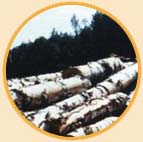Increased Timber
 Given the
changing demands on forests and the need to manage this resource in a
sustainable manner, can Alberta's current level of harvest be maintained or
increased? One way to increase timber supply is through enhanced forest
management, which includes weeding, thinning, fertilizing and a greater reliance
on planting genetically improved trees. All of these activities are aimed at
improving the regeneration of commercial tree species.
Intensively managed plantations could provide higher volumes of timber per
hectare than natural forests, and require less land to produce given volume of
wood. However, these silviculture treatments are expensive and would only be
cost-effective on the most productive sites near mills. Given the
changing demands on forests and the need to manage this resource in a
sustainable manner, can Alberta's current level of harvest be maintained or
increased? One way to increase timber supply is through enhanced forest
management, which includes weeding, thinning, fertilizing and a greater reliance
on planting genetically improved trees. All of these activities are aimed at
improving the regeneration of commercial tree species.
Intensively managed plantations could provide higher volumes of timber per
hectare than natural forests, and require less land to produce given volume of
wood. However, these silviculture treatments are expensive and would only be
cost-effective on the most productive sites near mills.
Although more
intensive forest management could lead to an increase in allowable harvest
levels, many companies are reluctant to make this investment on land they do not
own without a long-term guarantee of the right to harvest the trees grown.
Alberta is trying a new arrangement with companies holding forest management
agreements, allowing the flexibility to harvest any additional timber that
results in an increase in their silviculture investment. Intensive silviculture
presents some challenges for ecological management of forests because it relies
on more human intervention and greater use of plantations, fertilizers and
herbicides. Several forest industry companies are conducting research and trials
to find the best methods to increase timber supply in some areas, while managing
extensive areas as forest ecosystems.
Department of the Environment. State of the Environment Report, Terrestrial Ecosystems. Edmonton: n.p., 2001. With permission from Alberta Environment.
  |
|
 Heritage Community Foundation Presents
Heritage Community Foundation Presents





